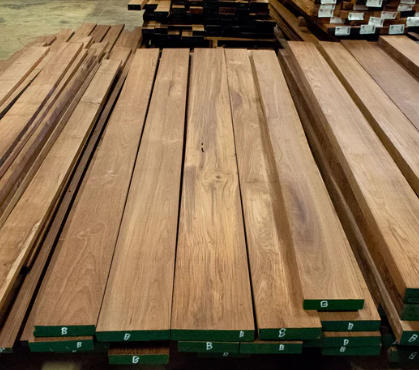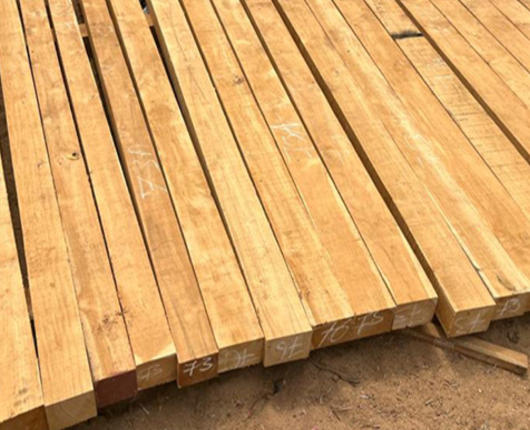Views: 222 Author: Rebecca Publish Time: 2025-10-21 Origin: Site











Content Menu
>> Distinct Features of Genuine Teak
● Understanding Teak Wood Grades
>> Grade A Teak
>> Grade B Teak
>> Grade C Teak
● Common Types of Teak on the Market
>> Burmese Teak (Myanmar Teak)
>> Costa Rican and Brazilian Plantation Teak
● Where to Purchase Authentic Teak Wood
>> 1. J. Gibson McIlvain Company (USA)
>> 3. Carib Teak (Florida, USA)
>> 4. Brazilian Lumber (Miami, USA)
>> 5. Edensaw Woods (Seattle, WA)
>> 6. Woodworkers Source (Arizona, USA)
● How to Identify Genuine Teak Before You Buy
● Sustainability and Legal Certification
● Practical Buying Tips for Online Orders
● Real-World Uses for Teak Wood
● FAQs
>> 1. What is the current price range for Grade A teak?
>> 2. Is plantation teak as good as Burmese teak?
>> 3. How long does teak wood last outdoors?
>> 4. Can teak furniture be painted or stained?
>> 5. How can I maintain teak furniture's appearance?
Teak wood is one of the most prized hardwoods used in luxury furniture, boats, flooring, and architectural applications. With its golden hue, fine grain, and natural resistance to weather and insects, it stands apart as one of the most durable and elegant materials available. Yet, finding authentic and ethically sourced teak is not as simple as walking into a lumber store. The process requires understanding the grades, origins, and ethical certifications that guarantee quality.
This extended guide will show you where to buy teak wood, how to distinguish genuine teak from substitutes, the types available on the market, and how to ensure your purchase supports sustainable forestry.

Teak (Tectona grandis) has been famous for centuries due to its exceptional durability and aesthetic appeal. Originally native to countries like Myanmar, India, and Thailand, its cultivation has spread to parts of Africa, Central America, and Indonesia.
What makes teak so unique is its high oil and silica content, which protects it from termites, rot, and decay. These qualities make it ideal for marine use, luxury decking, and outdoor applications where other woods may warp or crack over time.
- Rich natural oils that prevent decay without chemical treatment.
- High tensile strength making it resistant to physical wear.
- Smooth, straight grain with consistent texture.
- Golden-brown color that deepens to a beautiful patina with age.
- Non-slip properties, perfect for decks and wet environments.
The combination of beauty, performance, and longevity is why teak remains among the most expensive woods globally, with genuine Burmese teak commanding a premium.
When buying teak wood, knowing its grade is vital to determine quality, price, and suitability for your project. Teak is commonly divided into three major grades: A, B, and C.
Grade A teak represents the heartwood from the center of a mature teak tree, usually between 25 and 50 years old. This section of the tree contains the highest concentration of natural oils and silica.
Characteristics of Grade A teak:
- Uniform honey-golden color and smooth texture.
- Tight, straight grain and minimal knots.
- Naturally glossy surface that feels oily to the touch.
- Resistant to moisture, insects, and UV degradation.
Because only about 20–25% of the harvested log qualifies as Grade A, this wood is rare and expensive. It's best suited for yacht decks, high-end furniture, and outdoor structures that face harsh elements.[1][2][7][10]
Grade B teak is taken from the outer heartwood, or transitional layer between heartwood and sapwood. It's slightly lighter in color and has lower oil content, meaning it requires more maintenance.
- Minor color variations, occasional knots, and less shine.
- Still offers decent durability but less water resistance.
- Cheaper than Grade A and often used in indoor furniture or semi-exposed areas like patios.
- Can benefit from protective sealants to improve longevity.[3][5][10]
Grade C teak comes from the sapwood of young or plantation trees—soft, porous, and pale in color.
- Virtually no natural oil, prone to warping and cracking.
- Uneven color with frequent defects or knots.
- Best used for low-cost applications or decorative panels that are not exposed to moisture.[9][1]
When quality and durability matter, avoid Grade C for structural or outdoor use. Unscrupulous suppliers may chemically stain Grade C wood to mimic Grade A, so verify through trusted vendors.[9]
While grades determine internal quality, teak wood is also categorized by origin, influencing its visual characteristics and price.
Known as the gold standard, Burmese teak is naturally harvested and contains superior oil and silica levels. It is denser, darker, and more stable—ideal for marine applications. However, export restrictions make it expensive and harder to source legally.
Grown on FSC-certified plantations under government supervision, Indonesian teak is sustainably managed and highly popular for export. It shows consistent color and fine grain suitable for furniture, flooring, and decking.
Sourced from Ghana or Nigeria, it's an affordable alternative. It tends to have lighter color and lower oil content but is still suitable for moderate outdoor use.
Tropical climates in Latin America allow fast growth. Although plantation-grown teak lacks the density of old-growth wood, it's a sustainable and ethical option for large-scale architectural projects.

Choosing where to buy teak wood depends on your project scale and location. The following suppliers are internationally known for proven authenticity and sustainable sourcing:
A leading importer of FEQ (First European Quality) Teak, this company provides marine-grade lumber for luxury yachts and architectural projects. They directly source from FSC-certified forests in Asia.
- Applications: Yacht decking, architectural trim, speciality joinery.
- Region served: USA, Caribbean, and Canada.
- Website: *mcilvain.com*
Offers an eco-certified collection of plantation-grown teak.
- Products: Decking, beams, boards, and slabs preplaned to specification.
- Special feature: Plantation teak with direct-to-customer online ordering.
- Website: *advantagelumber.com*
Specializing in both exotic and domestic lumber, Carib Teak is well-regarded among designers and naval craftsmen.
- Offers hand-selected Burmese teak planks and rough lumber.
- Known for custom milling services.
- Website: *caribteak.com*
Their teak comes from legal plantations in South America under environmental compliance laws.
- Offers custom cutting, kiln drying, and bulk shipping.
- Website: *brazilianlumber.com*
One of the Pacific Northwest's top suppliers of import woods, including marine teak.
- Ideal for custom boat-building projects and high-end cabinetry.
- Offers on-site consultations for cut-to-size requirements.
- Website: *edensaw.com*
Perfect for hobbyists, small workshops, and residential DIY users.
- Ships small-batch orders of teak boards nationwide.
- Website: *woodworkerssource.com*
Since counterfeit teak is widespread, the following practical checks can help confirm authenticity:
1. Observe the Color – Genuine teak has a consistent golden-brown tone that darkens slightly over time.
2. Examine the Grain – Fine, straight, and evenly spaced grain lines indicate quality.
3. Feel the Surface – Authentic teak feels slightly waxy due to its natural oils.
4. Do the Water Test – Water droplets bead on real teak, proving oil saturation.
5. Smell the Wood – Genuine teak gives off a leathery, earthy aroma when freshly cut.
Avoid any supplier who cannot specify the origin, certification, or detailed grading of their teak.
Teak sourcing has faced scrutiny because of illegal logging in Myanmar. Responsible suppliers now rely on FSC (Forest Stewardship Council) or PEFC-certified teak plantation sources. Always request certification proving:
- Legal harvest under the Lacey Act (U.S.)
- Export permits
- Sustainable chain-of-custody documentation
Plantation teak not only helps protect old-growth rainforests but ensures farmers are paid fairly and forests are replanted for future generations.
Online teak shopping can be safe if you follow these guidelines:
- Read reviews and inspect seller certifications.
- Ask for detailed wood photos and grain shots.
- Compare grade specifications and thickness options.
- Request small samples before bulk orders.
- Check drying method (kiln-dried teak is optimal).
- Confirm freight and damage insurance before shipping.
A reputable online retailer should transparently display sourcing details and provide a satisfaction guarantee.
Teak's durability and visual appeal make it suitable for countless applications:
| Application | Recommended Grade | Benefit |
|---|---|---|
| Luxury Yacht Decks | Grade A (FEQ) | High oil content, anti-slip, weatherproof |
| Outdoor Patio Furniture | A or B | Withstands moisture and UV exposure |
| Indoor Flooring and Paneling | B | Elegant, long-lasting finish |
| Boat Accessories and Handrails | A | Resistant to salt damage |
| Decorative Interior Projects | B or C | Easy to machine and polish |
Purchasing teak wood requires informed decision-making. As a high-end material, understanding grading, source, and sustainability ensures that you get the best return on investment and protect the environment. Trusted suppliers like J. Gibson McIlvain, Advantage Lumber, and Carib Teak remain top choices for quality and responsible sourcing.
Whether crafting heirloom furniture or marine-grade structures, teak represents craftsmanship, endurance, and timeless beauty. Choose certified wood over dubious bargains—your final product and the planet will thank you.

As of 2025, prices average $30–$40 per board foot, depending on size, region, and certification. Imported FEQ teak commands the higher end of this range.
Plantation teak, while slightly lower in oil content, is an ethical and durable alternative that performs excellently for most residential and commercial applications.
High-quality Grade A teak can last 50–70 years or more without structural decay, even under constant weather exposure.
Yes, but it's generally unnecessary. Teak's natural color and oils protect it. If desired, use breathable, oil-based finishes to preserve its grain.
Clean it periodically with mild soapy water and use teak oil once per year. Avoid harsh cleaners that strip protective oils.
[1](https://www.cyan-teak-furniture.com/faqs/materials-construction/what-are-the-different-teak-grades)
[2](https://www.goldenteak.com/tgrades.htm)
[3](https://www.patioproductions.com/blog/common-questions/grades-of-teak-the-quality-for-your-outdoor-furniture-design/)
[4](https://www.countrycasualteak.com/our-quality-difference)
[5](https://www.hineighbor.com/blogs/the-journal/grade-a-teak)
[6](https://www.youtube.com/watch?v=KqNo3zthPSE)
[7](https://aquateak.com/blog/grading-teak-wood/)
[8](https://arbteak.com/blogs/news/abcs-of-teak-wood-can-you-buy-bad-teak)
[9](https://www.kaltimber.com/blog/what-are-the-different-teak-grades)
[10](https://teakplace.com.au/blogs/latest-news/understanding-the-differences-between-grade-a-b-c-teak)